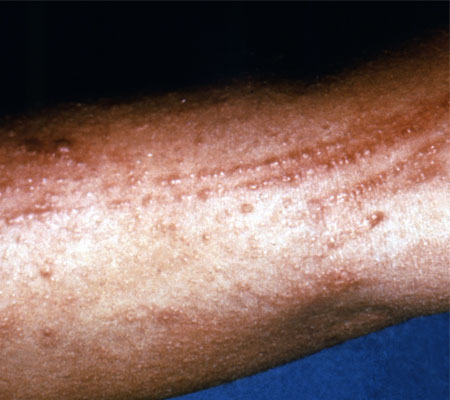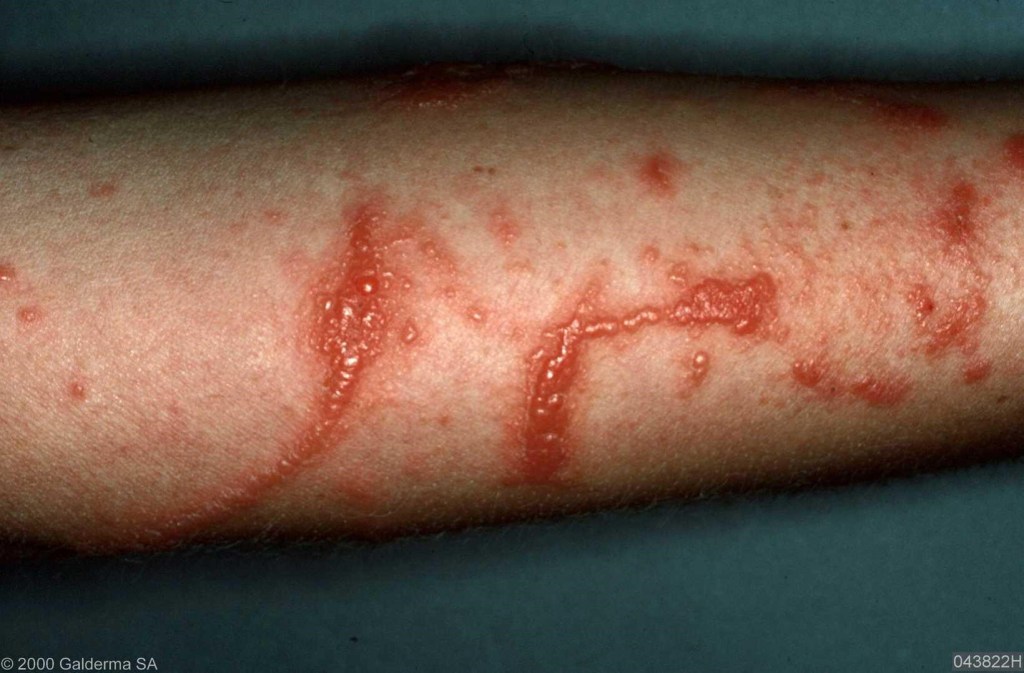Page Contents
OVERVIEW
This page is dedicated to organizing various examples of standardized exam questions whose answer is contact dermatitis. While this may seem a odd practice, it is useful to see multiple examples of how contact dermatitis will be characterized on standardized exams (namely the boards and the shelf exams). This page is not meant to be used as a tradition question bank (as all of the answers will be the same), however seeing the classic “test” characterization for a disease is quite valuable.
KEY CHARACTERISTICS OF THIS CONDITION (ON EXAMS)
When it comes to standardized exams, each topic has its own “code” marked by key buzzwords, lab findings, clues, etc. If you are well versed in this code you will be able to more quickly identify the condition that is being discussed, and get the right answer on the exam you are taking. Below is the “code” for contact dermatitis.
Chief Complaints:
- Rash that can often be itchy.
Patient History:
- Recent exposures: camping/hiking (exposure to poison oak/poison ivy)
Clinical Workup:
- Rash with blisters/vesicles/bullae and also with weeping/drainage
- Linear pattern of vesicle eruption: very characteristic description for this condition.
QUESTION EXAMPLES
Question # 1
A 30 year old woman comes to the clinic because she has a rash on her neck, arms, and hands. Before she developed this rash she explains that she was weeding and fertilizing her backyard in a tank top and shorts. She explains that she used sunscreen but denies the usage of any insect repellant. A dermatological exam reveals bright red papules, vesicles, and bullae, many of which are in a linear pattern on her forearms, and neck. There are oozing vesicles present on her hands. What is the likely diagnosis?
Explanation # 1
Rash + exposure to outdoors + linear arrangement of vesicles on skin = contact dermatitis
Question # 2
A 35 year old electrician comes to the clinic because he has a skin rash on his left leg. He denies any changes to his diet or the usage of any new soaps or detergents. A more detailed history revels that he recently worked on a repair job in a heavily wooded area. His past medical history is unremarkable for any chronic conditions or for any medications. A physical exam revels an uncomfortable male who keeps scratching at his leg. His cardiovascular and pulmonary exams are unremarkable. An image of his leg is shown below:

What is the likely diagnosis in this patient?
Explanation # 2
Rash + exposure to outdoors + linear arrangement of vesicles on skin = contact dermatitis
Question # 3
A 55 year old female comes to the clinic because she has a skin rash that has been present on her thighs. For the past month she has been applying a new cream to her thighs because she read that this product would make her skin “silky smooth”. Her past medical history is non-contributorary, and she does not take a chronic medications. A physical exam reveals a erythematous rash with blisters, ulcers, and there is also weeping drainage from the rash as well. What is the likely diagnosis in this patient?
Explanation # 3
Skin rash + exposure (cream) + blisters with weeping = contact dermatitis (allergy to cream)
Question # 4
A few days after taking a hike through the forest, a 35 year old male develops an intensely pruritic area on his forearm skin. This part of his skin was not covered with clothing on the hike. The rash is shown below:

The patent applies a topical ointment containing 1% hydrocortisone to the affected area which gives him some relief. His rash improves over the next 1-2 weeks. What condition did this patient likely suffer from?
Explanation # 4
Skin rash + exposure (hiking) + linear vesicular rash = contact dermatitis
Question # 5
A 26 year old male comes to the clinic because he has an itchy rash on all of his extremities. He recently came back from a camping trip in the woods earlier this week. A physical exam shows that there is a wide spread edematous and erythematous rash on his arms and legs that contains linear arrangements of vesicles. What is the likely diagnosis in this patient?
Explanation # 5
Skin rash + exposure (hiking) + linear vesicular rash = contact dermatitis
Question # 6
A 12 year old boy is brought to his pediatrician because he has been suffering from a pruritic rash for the past 2 days. The rash is on his legs. He explains that this rash began about one day after he played in a heavily wooded area with his best friend. Since then the rash as been spreading. His mother has taken his temperature and he has not had any fevers. The patient also explains that he has a pet turtle at home. A physical exam reveals the presence of an erythematous rash on the lower legs. There are bullous lesions filled with discharge, and there is a clear margin between the patient’s rash and his unaffected skin. What is the likely diagnosis in this patient?
Explanation # 6
Itchy rash + exposure to heavily wooded area + rash with bullae = contact dermatitis
TESTABLE FACTS ABOUT THIS TOPIC (BEYOND ITS IDENTIFICATION)
Many questions on standardized exams go beyond simply recognizing the underlying topic. Often there are specific testable facts regarding some aspect of the topic’s pathophysiology/management/clinical implications that are commonly asked. Some of these are listed below:
Cause:
- Type of immune reaction: type IV (delayed) hypersensitivity reaction
- What cells mediate the response: T-cells
Treatment:
- Avoid the exposure
Page Updated: 01.22.2017